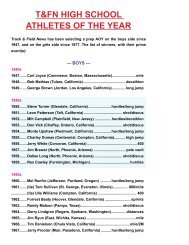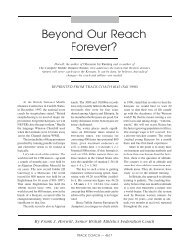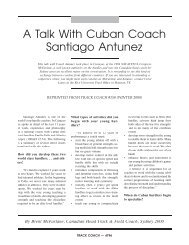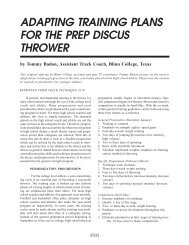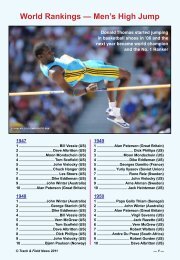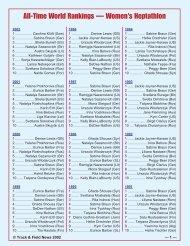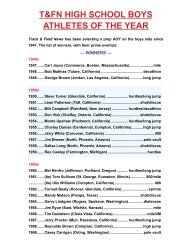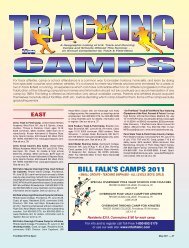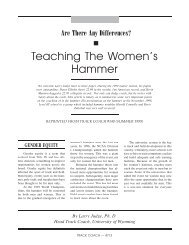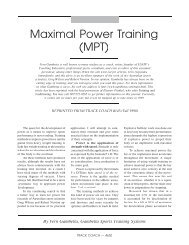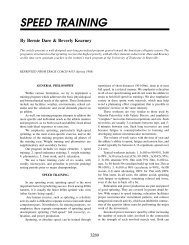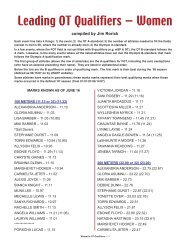Identifying And Developing Elite Hurdlers In The United States
Identifying And Developing Elite Hurdlers In The United States
Identifying And Developing Elite Hurdlers In The United States
You also want an ePaper? Increase the reach of your titles
YUMPU automatically turns print PDFs into web optimized ePapers that Google loves.
a student of the sport. Here it is 75 per<br />
cent teaching from the coach and 25<br />
per cent feedback from the athlete.<br />
Second Year Objectives<br />
(“Strength”):<br />
Continued development of five<br />
biomotor abilities, with a continued emphasis<br />
on overall fitness and strength.<br />
Continue to teach athlete hurdle<br />
technique and race modelling; have<br />
him/her participate in program development.<br />
Here it is 60 per cent coach and<br />
40 per cent athlete.<br />
Skill acquisition—this is where I<br />
see the most kinesthetic landmarks or<br />
“hot spots” in hurdle development. <strong>The</strong><br />
sophomore transition is an exciting one<br />
for me because I see huge gains during<br />
this year!<br />
Focus on strength development in<br />
the weight room. Athletes need to truly<br />
begin to challenge themselves!<br />
Third Year Objectives (“Speed”):<br />
Progress in developing the biomotor<br />
abilities. Athlete’s overall fitness<br />
and strength should be well established<br />
during this year.<br />
Athlete should be knowledgeable<br />
in his event, so much so that he is able<br />
to, in essence, “coach himself.” Here it<br />
is 50 per cent coach and 50 per cent<br />
athlete.<br />
Focus is on speed over the hurdles<br />
and development of top speed.<br />
Fourth Year Objectives (“Skill”):<br />
Development in all five biomotor<br />
abilities; should reflect the previous<br />
three year’s progression.<br />
Athlete’s knowledge level at its<br />
highest; can coach himself or others<br />
and have an “educated eye.” Here it<br />
is 25 per cent coach and 75 per cent<br />
athlete, if you’ve done your job.<br />
Top progression—athlete attains<br />
highest level of performance possible.<br />
Skill acquisition is the highest.<br />
Focus on getting to that next level<br />
by introducing most advanced hurdle<br />
drills/methods.<br />
Adhering to the fundamentals of<br />
sprint training principles and exercise<br />
selection principles throughout the program,<br />
easy to hard and part to whole<br />
is absolutely critical. However, skill<br />
acquisition must be sequenced through<br />
a series of exercises that are simple<br />
to complex, easy to hard and part or<br />
whole.<br />
Coaches should remember that<br />
hurdling is a complex motor skill and<br />
involves a fear factor, so“chaining” and<br />
“shaping” to modify form/technique<br />
should be utilized. For example, the<br />
coach should use stages of hurdle drills<br />
for skill acquisition such as starting<br />
with runs over sticks or pizza boxes<br />
placed on the track with a discounted<br />
three-step stride pattern that allows the<br />
athlete to sprint between “hurdles” to<br />
develop rhythm. <strong>The</strong>n implement a<br />
gradual increase of hurdle height and<br />
distance at the appropriate times. Another<br />
example would be to start hurdles<br />
with stationary/in-place hurdle drills,<br />
then advance to walking/skipping drills,<br />
and finally to running/rhythm drills.<br />
<strong>The</strong> coach should also be cognizant<br />
of “chaining,” which refers to the strategy<br />
in which the teachable components<br />
(or links) in the chain are reinforced in<br />
a specific order, or sequence, to form<br />
more complex behavior that ultimately<br />
occurs as as single cohesive performance<br />
(Sherman, 1995).<br />
<strong>In</strong> other words, divide hurdle tasks<br />
into smaller steps and arrange in sequence<br />
for instruction, appropriate for<br />
the level of that particular athlete. For<br />
example, use side-of-the-hurdle drills<br />
to isolate trail or lead leg actions. <strong>The</strong><br />
coach and athlete should use a detailed<br />
task analysis for skill acquisition to<br />
discriminate correct or incorrect movements.<br />
It should be noted that sequencing<br />
should be used in developing all five<br />
biomotor abilities in the annual plan.<br />
For example:<br />
Speed: acceleration—top speed—speed<br />
endurance<br />
Stamina: extensive tempo—intensive<br />
tempo—speed endurance<br />
Strength: general/postural strength—<br />
max—power—maintenance<br />
Skill: stationary—marching—running<br />
<strong>The</strong> athletes who have started<br />
hurdling specialization at an older age<br />
(14-17), after being in a sport other<br />
than track and field, and who are also<br />
relatively physically developed and<br />
coordinated, can go through an accelerated<br />
learning process (Korchemny,<br />
1996). <strong>The</strong> coach must first address<br />
the weak areas of the hurdler. Overall<br />
fitness and improvement of biomotor<br />
abilities (strength, skill, suppleness,<br />
stamina, speed) to build base foundation<br />
should be a priority; however, an<br />
introduction to hurdling can occur during<br />
this stage of development. Modified<br />
hurdling with a focus on rhythmic units<br />
can be introduced. <strong>The</strong> junior hurdler<br />
should rehearse a variety of hurdling<br />
skills using barriers of different heights<br />
and distances. For example, she should<br />
practice hurdle technique over 24-30<br />
inch barriers and run distances that<br />
facilitate fast execution of a three-step<br />
rhythm.<br />
Whether the athlete is in high<br />
school, college, or post-college, a<br />
combination of hurdle drills should be<br />
utilized (stationary—marching—running).<br />
Hurdle drills are very important<br />
to the advancement of mechanical<br />
proficiency by improving hip, knee,<br />
and ankle joint mobility, along with<br />
rhythm specialization. During the base<br />
preparation period a higher volume of<br />
drills (200-225 hurdle movements per<br />
session) are used with more emphasis<br />
on stationary and marching drills. During<br />
the pre-competitive and competitive<br />
periods, marching and running drills are<br />
employed (75-125), mostly performed<br />
in the warmup.<br />
Lastly, during the competitive period,<br />
the focus is on horizontal speed<br />
and technical perfection in the running<br />
and rhythm hurdle drills. It should be<br />
noted that hurdler rhythm endurance<br />
needs to get special attention during<br />
the competitive period, thus hurdlers<br />
need to run over 12-14 hurdles that are<br />
discounted throughout.<br />
With regard to running both<br />
hurdles, it is my philosophy that a 400<br />
hurdler should also train and compete<br />
in the 100H (remember that this cannot<br />
work both ways). This will enable long<br />
TRACK COACH — 4508



